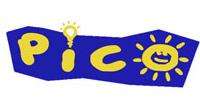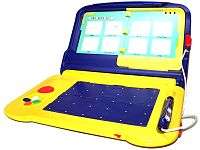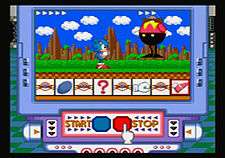Sega Pico
 | |
 | |
| Also known as | Kids Computer Pico |
|---|---|
| Manufacturer | Sega |
| Type | Video game console |
| Generation | Fourth generation era |
| Release date |
‹See Tfd› ‹See Tfd› |
| Introductory price |
JP¥13,440 US$139 CN¥690 US$49.95 (Majesco) |
| Discontinued |
‹See Tfd› |
| Units sold |
JP: 3.4 million NA: 400,000 (as of January 1996) |
| Media | "Storyware" (Cartridge) |
| Successor | Advanced Pico Beena |
The Sega Pico, also known as Kids Computer Pico (キッズコンピューター・ピコ Kizzu Konpyūtā Piko), is an educational video game console by Sega. Marketed as "edutainment", the main focus of the Pico was educational video games for children between 3 and 7 years old. The Pico was released in 1993 in Japan and 1994 in North America and Europe, and later reached China. It was later succeeded by the Advanced Pico Beena, which was released in Japan in 2005. Though the Pico was sold continuously in Japan through the release of the Beena, in North America and Europe the Pico was less successful and was discontinued in early 1998, later being rereleased by Majesco. Releases for the Pico were focused on education for children and included titles supported by licensed franchised animated characters, including Disney and Sega's own Sonic the Hedgehog series. Overall, Sega claims sales of 3.4 million Pico consoles and 11.2 million game cartridges, and over 350,000 Beena consoles and 800,000 cartridges.
Design and software

Powered by the same hardware used in the Sega Genesis,[1] the physical shape of the Pico was designed to appear similar to a laptop. Included in the Pico are a stylus called the "Magic Pen" and a pad to draw on. Controlling the games for the system is accomplished either by using the Magic Pen like a mouse or by pressing the directional buttons on the console. The Pico does not include its own screen or RF output, and instead must be connected to a monitor through a VCR in order to be played.[2] Touching the pen to the pad would either allow drawing or animate a character on the screen.[3]
Cartridges for the system were referred to as "Storyware", and take the form of picture books with a cartridge slot on the bottom. The Pico changes the television display and the set of tasks for the player to accomplish each time a page is turned.[2] Sound, including voices and music, also accompanied every page. Games for the Pico focused on education, including on subjects such as music, counting, spelling, reading, matching, and coloring. Titles included licensed animated characters from various franchises, such as Disney's The Lion King: Adventures at Pride Rock and A Year at Pooh Corner. Sega also released titles including their mascot, Sonic the Hedgehog, including Sonic Gameworld[3] and Tails and the Music Maker.[4]
History
Released at a price of JP¥13,440,[5] the Pico was released in Japan in June 1993.[6] In North America, Sega unveiled the Pico at the 1994 American International Toy Fair, showcasing its drawing and display abilities.[7] It was later released in North America in November 1994,[8] advertised before release at a price of approximately US$160[9] but eventually released at US$139. "Storyware" cartridges sold for US$39.99 to US$49.99. The Pico's slogan was: "The computer that thinks it's a toy."[3] After a lack of success, Sega discontinued the Pico in North America in early 1998. Later, a remake of the Pico made by Majesco was released in North America in August 1999 at a price of US$49.99, with Storyware selling at $19.99.[10][11] The Pico would later be released in China in 2002, priced at CN¥690.[12]
In 2000, Sega claimed that the Pico had sold 2.5 million units.[5] As of April 2005, Sega claims that 3.4 million Pico consoles and 11.2 million software cartridges had been sold worldwide.[13] The Pico was recognized in 1995 by being listed on Dr. Toy's 100 Best Products, as well as being listed in Child as one of the best computer games available. According to Joseph Szadkowski of The Washington Times, "Pico has enough power to be a serious learning aid that teaches counting, spelling, matching, problem solving, memory, logic, hand/eye coordination and important, basic computer skills."[14] Former Sega of America vice president of product development Joe Miller claims that he named his dog after the system because of his passion for the console.[1] By contrast, Steven L. Kent claims that Sega of Japan CEO Hayao Nakayama watched the Pico "utterly fail" in North America.[15] According to Warren Buckleitner of Children's Software Revenue, the Pico failed in North America due to a lack of credibility in the product.[10]
 | |
| Manufacturer | Sega |
|---|---|
| Type | Video game console |
| Generation | Sixth generation era |
| Retail availability |
‹See Tfd›
|
| Media | Storyware |
| Predecessor | Sega Pico |
Advanced Pico Beena
The Advanced Pico Beena, also known simply as Beena or BeenaLite, is an educational console system targeted at young children sold by Sega Toys, released in 2005 in Japan. It is the successor to the Pico, and marketed around the "learn while playing" concept. According to Sega Toys, the focus of the Advanced Pico Beena is on learning in a new social environment, and is listed as their upper-end product. Topics listed as being educational focuses for the Beena include intellectual, moral, physical, dietary and safety education.[13] The name of the console was chosen to sound like the first syllables of "Be Natural".[16]
Compared to the Pico, the Beena adds several functions. Beena can be played without a television, and supports multiplayer by a separately sold additional Magic Pen. The console also supports data saving. Play time can be limited by settings in the system. Some games for the Beena also offer adaptive difficulty, which becomes more difficult to play based on the skill level of the player.[17] The Beena Lite, a cheaper version of the console, was released on July 17, 2008. At the time of its release, Sega estimated that 350,000 Beena consoles had been sold, and 800,000 game cartridges.[18]
See also
References
- 1 2 Horowitz, Ken (February 7, 2013). "Interview: Joe Miller". Sega-16. Retrieved January 10, 2014.
- 1 2 "Sega's Younger Side: Pico and Sega Club Software". GamePro (65). IDG. December 1994. p. 80.
- 1 2 3 Beuscher, David. "Sega Pico - Overview". Allgame. Archived from the original on April 24, 2011. Retrieved September 1, 2014.
- ↑ "Tails and the Music Maker". Allgame. Archived from the original on November 16, 2014. Retrieved November 12, 2012.
- 1 2 "Sega Pico information". Sega Toys. Archived from the original on April 8, 2009.
- ↑ "Sega Pico Q&A". Sega Toys. Archived from the original on August 27, 2008.
- ↑ Fainaru, Steve (February 18, 1994). "It may be a Toy Fair, but it ain't kid stuff: High-tech goods shine at industry show". The Boston Globe. Retrieved September 1, 2014 – via HighBeam Research(subscription required).
- ↑ "Sega captures dollar share of videogame market -- again; diverse product strategy yields market growth; Sega charts path for 1996.". Business Wire. The Free Library. January 10, 1996. Retrieved September 29, 2011.
- ↑ Gillen, Marilyn A. (July 9, 1994). "Sega, Nintendo Bring Big Plans To CES". Billboard. Nielsen Business Media, Inc. 106 (28): 73. Retrieved September 29, 2011.
- 1 2 "Edison, N.J.-Based Firm Signs Video Game Distribution Deal with Sega.". Home News Tribune. August 6, 1999. Retrieved September 29, 2011 – via HighBeam Research(subscription required).
- ↑ "Majesco Signs Licensing Deal to Distribute Sega Pico Educational Systems: Systems Will Be Available In All Major Toy Retailers By Holiday Season". Business Wire. August 5, 1999.
- ↑ "Sega Toys markets Pico computer toy in China.". Japan Toy and Game Software Journal. March 25, 2002. Retrieved September 1, 2014 – via HighBeam Research(subscription required).
- 1 2 "Sega Toys Business Strategy". Sega Toys. Archived from the original on December 16, 2005.
- ↑ Szadkowski, Joseph (February 26, 1996). "ROMper Room: The Best in Play". The Washington Times. Retrieved September 1, 2014 – via HighBeam Research(subscription required).
- ↑ Horowitz, Ken (May 9, 2006). "Interview: Steven Kent". Sega-16. Retrieved September 1, 2014.
- ↑ "Beena(ビーナ) シリーズ" (in Japanese). Sega Toys. Archived from the original on July 6, 2014. Retrieved October 23, 2014.
- ↑ "Beena Q&A". Sega Toys. Archived from the original on December 12, 2005. Retrieved September 1, 2014.
- ↑ "『BeenaLite(ビーナライト)』7月17日新発売" (PDF) (in Japanese). Sega Toys. June 18, 2008. Retrieved October 23, 2014.